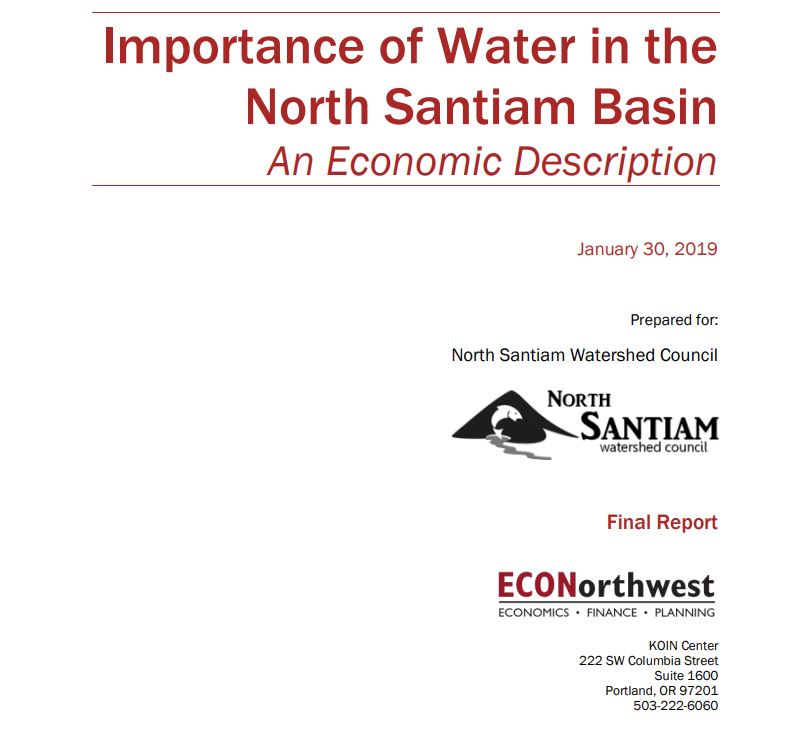
North Santiam: Building “the business case” for investing in projects that promote watershed resiliency
Goal: To engage business leaders and stakeholders in the Willamette Valley/North Santiam Watershed to make ‘the business case’ for investing in projects that promote watershed resiliency.
Duration: September 2017 through April 2018
Location: Marion and Linn County – North Santiam Basin and the communities dependent on its water resources.
Project Summary:
A North Santiam Watershed Collaborative Planning initiative started in 2009 when the City of Salem and the North Santiam Watershed Council (NSWC) asked Oregon Consensus to conduct a neutral assessment of the potential for collaboration relating to water management in the North Santiam Basin. The assessment consisted of interviews with parties representing a range of perspectives on issues and concerns related to water management. Since 2009, the City of Salem and the NSWC have been holding an annual basin summit to assess and discuss critical watershed issues that could impact the watershed ecosystem and the people who depend on it. To date, topics covered include the following: watershed data management, emergency spill response, flooding, drought, and watershed scale planning.
In April 2013, stakeholders were asked a series of questions to identify what the group wanted to focus on moving forward. One question was what is your highest priority for the North Santiam basin efforts? Of the possible responses, “drought emergency” received the most votes. In response to this input, the NSWC collaborated with the Santiam Water Control District and other local watershed partners during the fall of 2015 to create a Drought Contingency Plan for the North Santiam River Basin.
Funded by a grant from the U.S. Bureau of Reclamation to help fund drought planning efforts, eleven partners agreed to assist the Santiam Water Control District with meeting the 50/50 cost share grant obligations, including: City of Salem, City of Stayton, Stayton Fire, Linn SWCD, Marion County, Marion SWCD, NORPAC Foods, Inc., North Santiam Watershed Council, Oregon Department of Agriculture, Oregon Department of Environmental Quality and Oregon Department of Forestry. Grant funds were used to contract GSI Water Solutions and subcontractor David Evans and Associates to help develop this much-needed plan. A local stakeholder task force was formed in the winter of 2016 to help guide the development of a watershed scale plan. As required by the BOR grant, the Plan tries to answer the following three questions:
- How will we recognize the next drought in the early stages?
- How will drought affect us?
- How can we protect ourselves from the next drought?
To answer these questions, the irrigation district and its partners created a task force charged with developing a North Santiam Basin Drought Contingency Plan in 2016. The goal of this Plan is to build long-term resiliency to drought in order to minimize impacts to the communities, local economies, and the critical natural resources within the watershed. Link to North Santiam Drought Contingency Plan
After identifying the watershed assets vulnerable to drought, the task force developed a list of potential mitigation actions that could help reduce risks and impacts before drought. However, missing from the vulnerability assessment is the critical information that captures the economic data, in particular related to the industries dependent on the water resource of the basin both in and surrounding the watershed.
To develop a comprehensive watershed resiliency plan, data on direct economic impacts of droughts on the region’s economy (agricultural production, other water-dependent manufacturing, and recreation-based businesses), communities (continued growth and economic development), and watersheds (habitats, species, and ecosystem services) is needed. Without this information, it will be difficult (if not impossible) to garner the consensus necessary to propose, finance and build infrastructure projects that will lead to greater resiliency throughout the Willamette River Basin.
ECONorthwest recently completed a study of the ‘water story’ in a portion of the Yakima Basin.[1] Led by researcher Ed MacMullan, watershed stakeholders contributed data capturing the ecological, recreational, and economic values associated with water use in this region. The process of collecting, evaluating, and synthesizing those data also involved regular outreach to state and federal officials, water-dependent businesses including agricultural production and processing, manufacturing, recreation and services, as well as Tribal representatives, and interests groups focused on fishery and related topics.
The North Santiam project will deploy Ed MacMullan to conduct a similar study of the full water story in the North Santiam Watershed. Working closely with NSWC Coordinator Rebecca McCoun, OBCCI consultant John Audley and Ed MacMullan will work together to do the following:
1) Collect economic and recreational data that captures the untold story of economic and recreational activity throughout the watershed.
2) Collect relevant data from other water basins that can help describe water significance and economic values in the Willamette Valley/North Santiam Watershed.
3) Integrate the ecological data already collected by the Partners of the North Santiam and from other land managers in the basin to produce a unified story of water in the watershed. By doing so we will help grow consensus among watershed stakeholders for steps that will promote greater resiliency throughout the basin.
Timeline:
- November 17, 2017: Project kick-off meeting with watershed stakeholders
- November 2017-December 2018: Ed MacMullan will aggregate ecological, recreational, and economic value data to portray the water story in the subbasin
- December: Along with our other water infrastructure projects, the North Santiam Watershed project will be part of our focus on rural infrastructure investments during the Oregon Business Leadership Summit on Monday, December 4, 2017.
- February: We will reconvene the stakeholders to review a draft assessment document and provide feedback.
- April 2018: We will present our findings at the Annual North Santiam Basin Summit.
Why the Oregon Business Council Charitable Institute?
Three years ago, OBC launched the Rural Economic Vitality Project (REV) designed to better connect priorities set by the Leadership Summit and Business Plan to those articulated by our rural business leaders. Water resiliency touches all aspects of economic, community, and watershed health in this region. Investing in Oregon’s rural infrastructure to help grow rural economies and empower rural communities to play a larger role in shaping the policies and programs that affect their lives is one of the highest priorities stemming from this work.
For many years, OBC has made investing in water infrastructure a high priority for its work in rural areas of the State. Their initial focus on the need to invest in water infrastructure in the Umatilla basin led to the creation of a state water infrastructure-funding program (SB 839). The Umatilla water storage project has not yet been built, in part because the agricultural water users in the region feel that “the business case for investing in water infrastructure” has not yet been successfully made.
Given OBC’s historical interest in water infrastructure, it made sense to emphasize water as they continue to grow the REV project by prioritizing infrastructure. One of their goals for 2017 is to identify three basins where making the business case for investing in specific water infrastructure projects would help local stakeholders realize their goals (i.e. the evidence of our success lies in whether or not discrete infrastructure projects actually get built). Given the importance of this Basin and Watershed to the overall health of Oregon’s economy, and the support to engage they have heard from our business leaders, they hope to make the North Santiam Watershed project one of our three areas of focus for 2017-2018.
Project partners include:
- North Santiam Watershed Council: NSWC will be one of two key partners. The OBCCI efforts to make the business case will be coordinated closely with their overall project leadership.
- North Santiam Watershed Stakeholders contributing to the funding of the project include: Marion Soil & Water Conservation District, Marion County and the City of Salem. Together they are contributing $20,000 in cash match toward the economic assessment
- Ed MacMullan, ECONorthwest: OBCCI will contract Ed to serve as our technical storyteller
- John Audley: will coordinate business community involvement in the project. To keep project costs down, he will assume responsibility for data collection and business outreach coordination. To the extent that other NSWC members wish, John can also serve as a liaison to federal and state government and elected officials.
- The Ford Family Foundation: TFFF is the principal supporter of OBCCI rural economic outreach. TFFF funds allow OBCCI to cover the cost of John Audley’s role as project lead, enabling OBCCI to invest the majority of our MMT grant request to pay for most of ECONorthwest’s time and skills.
- Meyer Memorial Trust Grant has granted the Oregon Business Council Charitable Institute $30,000 to fund the economic analysis work ECONorthwest will be conducting.
Deliverables:
- Tell the North Santiam River Basin “water story.”
- The North Santiam Watershed project will be part of our annual Business Summit, offering an opportunity to educate up to 1500 business and other leaders about the priorities set by Willamette Valley basin water stakeholders
- The process of writing the story will be closely coordinated with outreach to state and federal elected officials
- Possible specific projects depend in large measure on the consensus of the group. To date, their ideas include the following projects:
- Improvements to irrigation automation and efficiency, improvements to the City of Salem’s drinking water transmission lines and improving the North Santiam Canyon Waste Water infrastructure. The analysis will look at these projects when looking at the cost benefit analysis of action verses no action.
- Establishment of a Santiam Basin Fund: A Fund would support a range of water-related projects important to local stakeholders.
Project Budget:
Total Project Budget: $70,000
ECONorthwest Consultant (Ed MacMullan) $50,000
John Audley Consulting (John Audley) $20,000
[1] Yakima Basin Analysis: https://fortress.wa.gov/ecy/publications/documents/1712009.pdf
February 19, 2019 Meeting:
ECONW _NSW Final Presentation2-19-19
Talking Points- ECONorthwest Report 2-2019
Economic Importance of Water in NSW_FINAL_2019
June 2018 Meeting Materials:
North Santiam Value of Water Phase 2 Scope of Work 5-7-18
North Santiam Value of Water Phase 1 Tech Memo-5-7-18
Kick Off Meeting: November 17, 2017 at Trexler Farm Cafe (10 to 12pm)
Meeting Handouts
Tech Memo Econ N Santiam
Building the Case Analysis Process – One Pager
North Santiam Watershed Council – Power Point Presentation
Building a Case Presentation 11-17-17

